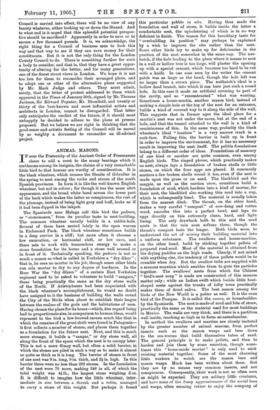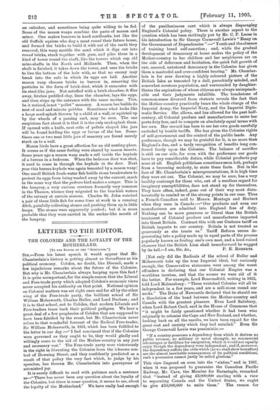I F ever the Fraternity of the Ancient Order of Freemasons
chose to add a crest to the many bearings which it emblazons among its insignia, the claims of a very remarkable little bird to that honour are worthy of consideration. It is the black wheatear, which crosses the Straits of Gibraltar in the spring to nest among the rocks and stones of the south Spanish provinces. In form it is like the well-known English wheatear, but not in colour ; for though it has the same alert appearance, and the broad white band across the lower part of the back which makes the latter so conspicuous, the rest of the plumage, instead of being light grey and buff, looks as if it had been dipped in the inkpot.
The Spaniards near Malaga call this bird the pedrero, or " stonemason," from its peculiar taste in nest-building. The common wheatear usually builds in a rabbit-hole. Several of them have nested lately in the open warren in Richmond Park. The black wheatear sometimes builds in a deep crevice in a cliff; but more often it chooses a low excavation, or horizontal cleft, or low cave, and there sets to work with tremendous energy to make a stone foundation for its house and a stone wall around or in front of it. Technically speaking, the pedrero is not so much a mason as what is called in Yorkshire a " dry diker " ; that is, he uses no mortar in his job, though some other birds can mix mortar to dry to any degree of hardness. In the Boer War the "dry dik-ers " of a certain East Yorkshire regiment used to be asked to volunteer to build " sangars," those being practically the same as the dry stone walls of the North. If Aristophanes had been acquainted with the black wheatear's accomplishment, he would no doubt have assigned to it the business of building the walls round the City of the Birds when about to establish their league between the realms of the gods and the habitations of men. Having chosen the place for its home—which, due regard being had to proportionate size, in comparison to human ideas, would represent to the bird a low-browed cavern much like that in which the remains of the great sloth were found in Patagonia— it first collects a number of stones, and places them together as a foundation for the future nest. Next, and this is much more strange, it builds a " sangar," or dry stone wall, all along the front of the space which the nest is to occupy later. This is not a mere flimsy wall, but often a solid barrier, in which the stones are piled in such a way as to make it almost or quite as thick as it is long. The barrier of stones in front of one nest was 9 in. long, 9 in. thick, and 24 in. high. In this barrier there were no leas than 282 stones. In the foundation of the nest were 76 more, making 348 in all, of which the total weight was 44 lb., the largest stone weighing 2 oz. It is difficult to imagine how the little wheatear, inter- mediate in size between a thrush and a robin, managed to carry a stone of this weight. But perhaps it found
this particular pebble in situ. Having thus made the foundation and wall of stone, it builds inside the latter a comfortable nest, the upholstering of which is in no way deficient in finish. The reason for this hereditary taste for " overbuilding its position " may perhaps be explained by a wish to improve the site rather than the nest. Some other birds try to make up for deficiencies in the position of the nest somewhat in the same way. The nut- hatch, if the hole leading to the place where it means to nest in a wall or hollow tree is too large, will plaster the opening up with a special cement, which becomes too hard to be cut with a knife. In one case seen by the writer the cement patch was as large as the band, though the hole left was no larger than a crown piece. The nuthatch's ideal is a hollow dead branch, into which it can bore just such a round hole. In this case it made an artificial covering to part of the cavity, and so " reconstructed " what was wanting. Sometimes a house-martin, another mason bird, instead of making a simple hole at the top of the nest for an entrance, builds a kind of covered way to it along the side of the wall. This suggests that in former ages the ideal place for a martin's nest was not under the eaves, but at the end of a hole, and that the tunnel attached to the wall is a kind of reminiscence of this. In the same way, probably the black wheatear's ideal " location " is a very narrow crack in a rock-face. Failing this, the barrier is built up in front in order to improve the environment, for it has no necessary result in improving the nest itself. The pebble foundations belong to a different order of ideas. Foundations of masonry of one kind or another are quite common, even among English birds. The ringed plover, which practically makes no nest, always lays a foundation of broken shells or little stones, on which the four eggs are placed. It commonly scatters a few broken shells round it too, even if the nest is made upon the grass or on sand. The blackbird and the magpie, as well as the carrion crow, sometimes build a foundation of mud, which hardens into a kind of mortar, for their nest, the blackbird also working this mud into a cup, which is subsequently lined. The material is usually taken from the nearest ditch. The thrush, on the other hand, makes a very careful " compost" of cow-dung and rotten wood, smooths this into a perfect bowl, and lays its eggs directly on this extremely clean, hard, and light lining. The only drawback both to this and the mud nests is that the rain soon softens them, though the thrush's compost lasts the longer. Both birds seem to understand the art of mixing their building material into a uniform substance. The swallows and house-martins, on the other hand, build by sticking together pellets of prepared road-mud. Most of the material is obtained from the drying puddles on the high roads. Clearly, if not mixed with anything else, the tendency of these pellets would be to crumble when dry. But the swallow tribe are supplied with a mucous secretion which enables them to gum the particles together. The swallows' nests from which the Chinese " bird's-nest soup " is made are constructed of this mucous matter only ; while an Indian swift which builds little boat- shaped nests against the trunks of lofty trees practically makes them of dried saliva. The best mason among the birds of the New World is a potter as well. It is the oven bird of the Pampas. It is called the easara, or housebuilder, by the Spaniards. The nest is made of mud and bits of straw, practically the same as the material used for most buildings in Mexico. The walls are very thick, and there is a partition wall inside, reaching so high as to form an antechamber.
In method the swallows and martins are closely imitated by the greater number of animal masons, from perfect insects such as the mason wasps and bees down to the sea-worms that build themselves tubes of sand. The general principle is to make pellets, and then to harden and join them by some secretion, though some- times this " home-made mortar " is only used to stick existing material together. Some of the most charming little workers to watch are the mason bees and mason wasps. Much has been written about them. But they are by no means very common insects, and not conspicuous. Consequently, their work is not so often seen as might be expected. They are solitary little creatures, and have none of the fussy aggressiveness of the social bees and wasps, often seeming rather to enjoy the company of an onlooker, and sometimes being quite willing to be fed. Some of the mason wasps combine the parts of mason and miner. One makes burrows in hard sandbanks, but like the
old Suffolk squires who dug a moat round their future house, and formed the bricks to build it with out of the earth they
removed, this wasp moulds the sand which it digs out into
round bricks, stuck together with gum, and piles these in a kind of tower round the shaft, like the towers which cap old
mine-shafts in the North and Midlands. Then, when the shaft is finished, it takes down the tower, and uses the bricks to line the bottom of the hole with, so that no enemy may . break into the safe in which its eggs are laid. Another mason wasp chooses bricks to burrow in, removing the
particles in the form of brick-dust, which it excavates with its steel-like jaws. Not satisfied with a brick chamber, it flies away, fetches paddled clay, lines the chamber, lays the eggs, and then stops up the entrance with the same mortar. This, be it noticed, is not "pellet" masonry. A mason bee builds its nest of mud and minute pebbles. Sometimes what looks like a large mud-splash thrown by a child at a wall, or squirted up by the wheels of a passing cart, may be seen. The one suspicious fact about it is that it is the only mud-splash there. If opened with a knife, neat cells of pellets shaped like jars will be found holding the eggs or larvae of the bee. Some- times one or two neat little jars of masonry are found merely stuck on to a wall.
Mason birds have a great affection for an old nesting-place. It seems as if the same feeling were shared by mason insects. Some years' ago a mason wasp made a cell inside the keyhole of a bureau in a bedroom. When the bedroom door was shut, it used to come in through the keyhole in the door. Next year this bureau keyhole was again tenanted by a mason wasp! One small British fresh-water fish builds stone breakwaters to protect its eggs from being washed away by the current, much in the same way that the pedrero bird makes a sangar. This is the lamprey, a very curious creature formerly very common in the Thames. whence they migrated to the brackish waters of the estuary at certain seasons. Charles St. John watched a pair of these little fish for• some time at work in a running ditch, painfully collecting stones and pushing them up in little heaps. The stones were apparently pushed; but it is more probable that they were carried in the sucker-like mouth of the lamprey.







































 Previous page
Previous page